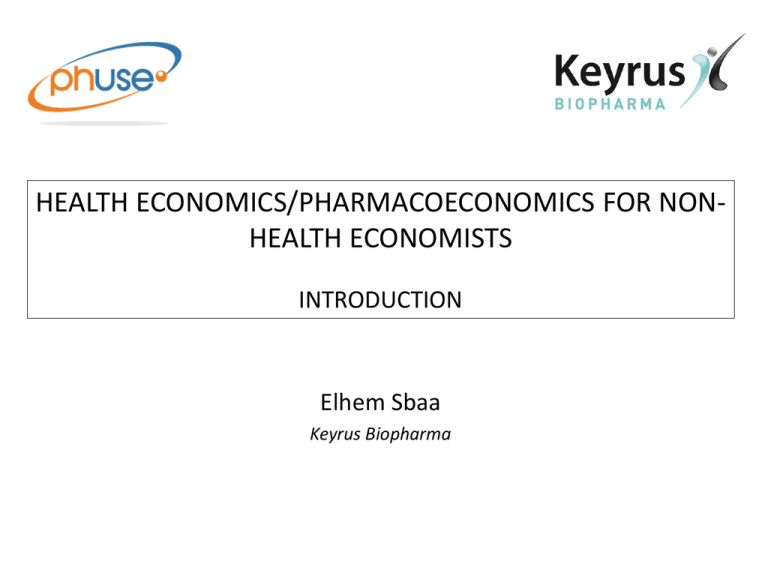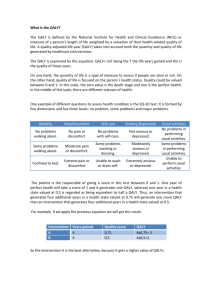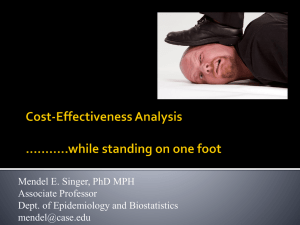HEALTH ECONOMICS/PHARMACOECONOMICS FOR NON- HEALTH ECONOMISTS INTRODUCTION Elhem Sbaa
advertisement

HEALTH ECONOMICS/PHARMACOECONOMICS FOR NONHEALTH ECONOMISTS INTRODUCTION Elhem Sbaa Keyrus Biopharma Objectives What Health Economics (HE) The link between clinical trials and HE The key questions need to be addressed for HE with payers How HE studies help to provide “the evidence” to address the questions of the payers The difference between cost-saving and cost-effective Contents Introduction and definitions How to position HE What is value and how to quantify? The 5 key questions for HE assessment What is the disease burden under study Link between clinical and economic burden What is the expected impact on cost & health outcomes of the new intervention? Is the new intervention cost-effective? What is its competitive advantage today and in the near future? Is the new intervention short term affordable? Conclusion Introduction Regulatory PAYERS Allocate the health care budgets to those interventions that offer the most health gain per unit of money HE evaluation helps answer this question How to position HE ? Economic and efficiency in Health become more important when budgets for health care are limited Less budget, more options, more demand: choice must be clear and explicit Safety Efficacy Quality Provider Prescriber Patient Money Payer The 5 key questions for HEassessment? To define the value statement of the new intervention What is the disease burden under study? What is the expected impact on cost & health outcomes of the new intervention? Is the new intervention cost-effective? What is its competitive advantage today and in the near future? Is the new intervention short term affordable? The 5 key questions for HEassessment? To define the value statement of the new intervention What is the disease burden under study? What is the expected impact on cost & health outcomes of the new intervention? Is the new intervention cost-effective? What is its competitive advantage today and in the near future? Is the new intervention short term affordable? The disease burden Frequencies per time unit and geographic entity: Incidence, prevalence, mortality, morbidity Quality of life (QoL) : impact of disease also expressed in QALYs Cost of Illness: Direct medical costs Indirect non-medical cost Direct Indirect Medical Cost related to the treatment of the disease from payers perspectives the up-coming expenditure on health care Non medical Expenses not related to health care, but are linked to disease (travel expenses, special diets, …) Loss of productivity due to absenteeism or premature death Example: Rotavirus mortality rate per 100 000 children <5 years of age, by country, in 2004 Deaths per 100 000 < 10 10 - 49 50 - 99 100 - 500 No data available This publication is available on the Internet at: www.who.int/vaccines-documents/; http://whqlibdoc.who.int/hq/2009/WHO_IVB_09.09_eng.pdf Link between clinical and economic burden Unit cost Clinical burden • Cost per case • Total # of cases • Length of stay Economic burden X • Cost per day for hospitalization = Total costs Estimates of Spn and NTHi diseases annual costs in Italy from the healthcare payer’s perspective Diseases Meningitis Bacteraemia Pneumonia Inpatient Outpatient Otitis media Inpatient Outpatient Total cost Annual number 350 4.500 Unit cost (€ 2009) 6.846 3.605 Total costs € 2.396.100 € 16.222.500 25.000 50.000 2.429 163 € 60.725.000 € 8.150.000 9.536 1.500.000 1.112 63 € 10.604.032 € 94.500.000 € 192.597.632 La Torre G et al. Poster, ISPOR 12th Annual European Congress, Paris-2009 Cost and Perspective Product cost Treatment cost Transportation cost Loss of productivity PERSPECTIVES 100 € 100 € 10 € 50 € 70% reimbursement for the product cost and treatment cost Public health care payer 70 € 70 € 0€ 0€ Patient 30 € 30 € 10 € 0€ Societal 100 € 100 € 10 € 50 € The 5 key questions for HEassessment? To define the value statement of the new intervention What is the disease burden under study? What is the expected impact on cost & health outcomes of the new intervention? Is the new intervention cost-effective? What is its competitive advantage today and in the near future? Is the new intervention short term affordable? How to measure the benefits of a new treatment ? Can be measured, for instance, in Life Years Saved (LYS) or Quality Adjusted Life Years (QALY) QALY: Quality adjusted life year Health is not only about life and death, but also about Quality of the life lived Quality is expressed as Value Index : 0 (worst) 1 (best condition) Utility Index Utility Index 1 1 0.6 0.7 0.6 1 6 0 6 0 10 0.6 x 10 = 6 QALY Utility Index 1 1 0.6 0.7 0.6 0 1.2 10 temps (0.7 x 10) – (0.6 x 10) = 1 QALY QALY = Utility x Life year Utility Index 6 10 temps 2.4 6 12 0 temps (0.6 x 12) – (0.6 x 10) = 1.2 QALY 10 12 temps (0.7 x 12) – (0.6 x 10) = 2.4 QALY How to measure the utility index The term "utility“ correspond to the health state of a person at a fixed time Economic theory: the choice made by a person between two or more products is determined by her/his budget, the price and the value she/he feels when making the choice Frequent method: EuroQol 5D (EQ-5D) Mobility Autonomy /self-care Usual activities Pain/discomfort Anxiety/depression The transformation from the EQ-5D to utility index is country specific For more info: http://www.euroqol.org/eq-5d/what-is-eq-5d.html Method SF36: 36 questions (physical component score and mental component score) Other methods… • Ref: http://www.euroqol.org/ (version française) • Drummond MF. et al., 2005 Example : Impact on the cost No treatment (A) Birth cohort: 198,733 Treatment (B) Difference (B-A) Costs (USD) treatment cost 0 82,000,000 82,000,000 Disease 1 cost 97,000 50,000 -47,000 Disease 2 cost 1,000,000 600,000 -400,000 Disease 3 cost 545,000,000 540,000,000 -5,000,000 Disease 4 cost 16,000,000 15,000,000 -1,000,000 562,097,000 637,650,000 75,553,000 Total direct costs The treatment is projected to reduce huge economic disease burden by preventing the diseases Conclusion Direct Impact on Clinical burden Economic burden QoL/QALY Indirect Impact on Herd Immunity The 5 key questions for HEassessment? To define the value statement of the new intervention What is the disease burden under study? What is the expected impact on cost & health outcomes of the new intervention? Is the new intervention cost-effective? What is its competitive advantage today and in the near future? Is the new intervention short term affordable? When is HE analysis necessary ? N: New C: current N N C C C C N N N C Product cost + other costs N = Total cost The new product/treatment is dominant: cost saving (Lower cost/higher QALYs) C Product cost + other costs= Total cost Economic assessment Health gain Analyse the ratio cost/effectiveness If the new product/treatment is cost-effective (Higher cost/higher QALYs) Ref: According to Lieven Annemans " L'économie de la santé pour non économistes" The traditional approach Comparative analysis of alternative treatments in terms of BOTH their COST and HEALTH CONSEQUENCES Treatment B (New) Treatment A (Current) Cost (CB) ∆C = CB - CA Effect. (EB) ∆E = EB - EA Cost (CA) Effect. (EA) Incremental Cost Effectiveness Ratio (ICER) ∆C ICER = --------∆E ∆C ICER = --------QALY Threshold value Positioning a new treatment (N) with the current treatment (C) Cost-effective Cost-saving N Effectiveness N Better, but not costeffective TIVs C Maybe maybe not? Game over N N Cost The threshold Value Country Currency Threshold local currency Threshold in Euro (Aug 2007) USA USD 50000-100000 36600-73200 UK GBP 30000 44500 Sweden SEK 500000 54000 The Netherlands EURO 20000 20000 New Zealand NDZ 20000 11200 Ref: Jolain B. 2006 Threshold Value WHO: • Cost/QALY < 1 GDP per capita = very cost-effective • Cost/QALY between 1 and 3 GDP/capita = cost-effective • Cost/QALY > 3 GDP per capita = not cost-effective According to the International Monetary Fund (2010) GDP per capita: Belgium= 42 630 USD UK = 36 120 USD Clinical trials vs health economics assessment Clinical Trial: Efficacy Time horizon: short time effect Multi-country trials Purpose = Authorization Strict protocol instructions Protocol induced resource use Protocol induced findings Health Economics Assessment Effectiveness Time horizon: long enough to capture all cost and effect associated to the treatment Country specific assessment Purpose = reimbursement “Do what you normally do” Real resource use Real clinical findings Models Mathematical models are required to estimate the total impact of the product over time on health benefit (individual and societal levels) The results of such modeling exercises are especially important for decision makers at product launch, when only data on efficacy and safety from short-term, randomised clinical trials are available Modelling uses efficacy data to estimate an intervention’s effectiveness in situations closer to reality by integrating epidemiological and local disease-management data Different modelling approaches exist to evaluate the total impact of new interventions We need models to assess the long term costs and QALYs Medical decision tree Success 0.800 Cost A = 1000 Cost B = 5000 Cost of failure = 10000 1000 10 QALY Treatment A 3000€ 9.6 0.8 x 1000€ + 0.2 (1000€ + 10000€) = 3000€ 0.8 x 10 + 0.2 x 8 = 9.6 QALY Failure 11000 0.200 8 QALY Treat disease X Success 5000 0.900 10 QALY Treatment B 6000€ 9.8 0.2 QALY gained 0.9 x 5000€ + 0.2 (5000€ + 10000€) = 6000€ 0.9 x 10 + 0.1 x 8 = 9.8 QALY Failure 15000 0.100 8 QALY ICER = (6000€ -3000€) / (9.8 – 9.6) = 15000€/QALY gained Medical decision tree Markov Models Model diseases in which risks are continuous over time and timing of events is important Different defined health states for the patients “transition probability” between the states Periods (cycles) during which the transition probability will take place Simple Markov model presentation healthy 0.1 sick 0.01 0.2 dead Transition probabilities change over time Uponstart start Upon After11year year After After22years years After After 3 years healthy healthy healthy 1000 1000 1000 890 890 792 792 705 sick sick sick 0 00 100 100 169 169 214 dead dead dead 0 00 10 10 39 39 81 total total total 1000 1000 1000 1000 1000 1000 1000 1000 The 5 key questions for HEassessment? To define the value statement of the new intervention What is the disease burden under study? What is the expected impact on cost & health outcomes of the new intervention? Is the new intervention cost-effective? What is its competitive advantage today and in the near future? Is the new intervention short term affordable? Competitive environment: find the difference Difference in Value: or in cost or in QALYs or combined Value can be measured at different levels: overall in the details If overall with no difference in sideeffects: easy winner In the details only due to Innovation (2 versus 3 doses; oral versus IM; less sideeffects) be precise and specific Cost difference can be a price difference only ! Value Difference Cost Combi QALYs Overall Details Precise Spec The 5 key questions for HEassessment? To define the value statement of the new intervention What is the disease burden under study? What is the expected impact on cost & health outcomes of the new intervention? Is the new intervention cost-effective? What is its competitive advantage today and in the near future? Is the new intervention short term affordable? Affordability or Budget Impact Analysis Even if a new healthcare intervention is cost-effective, can it be afforded? Total budget impact with and without vaccination € 160,000,000 € 140,000,000 Who will pay what, when, how from which budget? € 120,000,000 € 100,000,000 € 80,000,000 € 60,000,000 € 40,000,000 Incremental cost (= numerator of ICER) for eligible population at different time points provides estimate of budget impact over time € 20,000,000 No vaccination Vaccination €0 2006 2007 2008 2009 2010 2011 2012 2013 2014 2015



